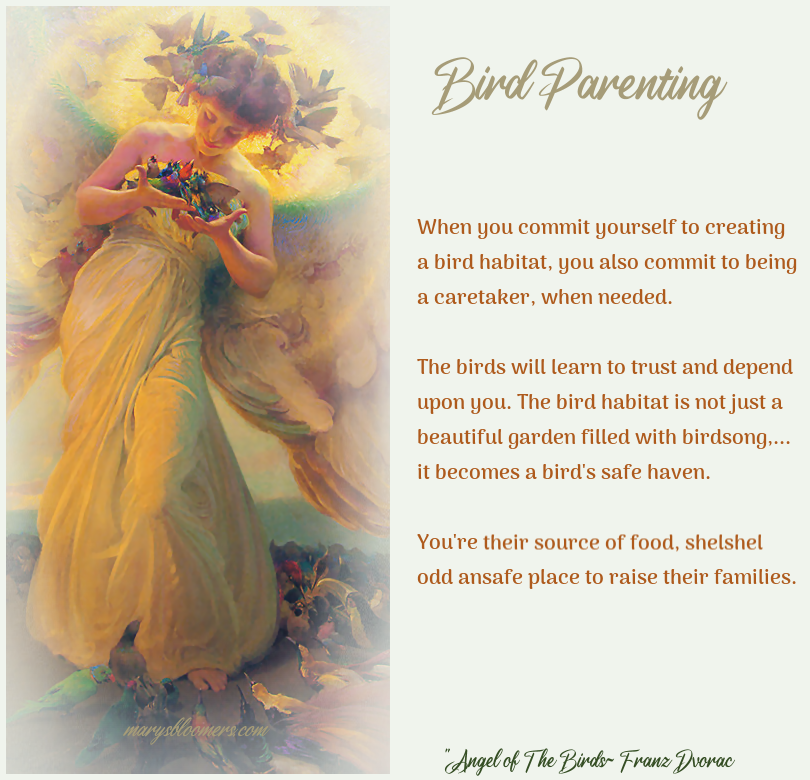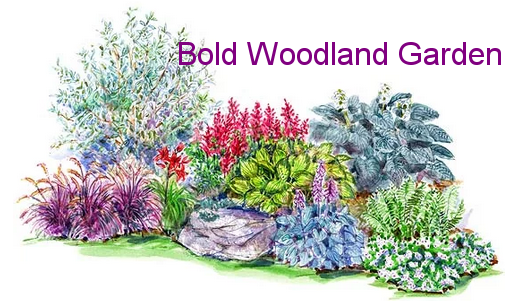|
If you decide to create a bird habitat as part
of your personal garden ecosystem, bear in mind that there are
responsibilities you need to commit to. It sounds wonderful if
you have the time, money and thought to put into it. If not,
it's better to just feed and watch the birds. I say this
because the better my bird habitat becomes, the more work i
need to do to keep the gardens well-designed to accommodate
them and keep the birds, safe. And to protect my landscapes as
well.
I liken it to keeping your eye on a curious,
adventurous 2 yr-old. Things you don't notice if you choose to
feed and birdwatch, are quite evident when you develop a
habitat especially for birds. The least of which, will be the
commitment to keep the birdfeeders and birdbaths clean and
filled. I've had so much pollen and algae to clean up this
year, i grew weary of cleaning things every few days. Once you
begin your habitat, and birds become used to where the food
and water is, you need to keep it up, so that it's available
to them all four seasons per year.
Birdseed gets expensive. I have
several barn-type hopper feeders that hold 5-8 lbs. of seed.
Pest birds like noisy Gackles, blackbirds and squirrels will
eat you out of house and home, and the smaller birds won't get
food unless you opt for feeders that deter large birds and
squirrels. My birds love the birdbaths for drinking and
splashing in. I've added solar fountains that fit in the bowls
to move the water, and they love it. If you do use birdbaths,
keep them filled all summer, and if you're unlucky enough to
suffer through a heat wave, remember that very hot water in
the birdbath is a bad thing. I add ice cubes or cold water
during the hottest parts of the day.

Birds have a routine once you start them on
it, so you do have to remember that when feeding and providing
necessities. Birds seem to be little garbage disposals and
will eat a lot of the stuff humans are throwing out. I
refer to this list first.
Adding your throwaways will
supplement the birdseed, save you a lot of money, and create a lot of
interest in returning to your feeders.
Your gardening habits will change a little.
I've had to do some creative planting and pruning to avoid
cutting branches holding nests. Pulling out seedlings that
inevitably sprout under feeders unless you have seed catchers
on the ground.. (i don't use them because i'm opposed to
attracting rodents). I do like to insert feeder poles inside
receptacles or plants filled with only dirt or stones, so that
I don't have to deal with it. If you have been successful in
creating a habitat, your garden will contain plants for food
and shelter. Removing these will require some thought. Birds
live in or return to their safe havens and raise their young
in these areas.
Words of Wisdom....You will also begin to look
before cutting and removing branches because if birds are
nesting and breeding, they will protect their space. I know
this because i've been chased across the yard by many a
screeching robin and other large birds that thought i was
threatening their babies when i forgot that wisdom. If you
have berries growing for food, you may need to cover them with
bird netting to protect them from hungry birds. I do not, as i
have enough food in feeders and growing naturally on shrubs
and plants to keep them satisfied. Birds also eat a lot of
bugs, so they won't bother your stuff if your feeders are
concentrated in an area away from your fruiting plants. I'm
happy to say that I haven't been pestered by mosquitoes or
aphids for years. My garden contains plants that will provide
berries in the winter, when birds are foraging for food. Keep
at least one birdfeeder filled and accessible in the winter.
You shouldn't stop feeding or providing water once birds have
gotten used to your source and decided to stay for the winter.
I leave a fairly large amount of dead branches and brush
around for their sheltering needs.
The
Most Vicious Predator in Your
Bird Habitat.... The Roaming Cat

Indiscrimate cutting and removing
of landscaping will
give predators like feral
and roaming pet cats a way to stalk
and get at the birds and their babies.
We
all know Parents of a roaming cat, or those who just feed
feral cats outdoors, and here's the rant...
You can
scroll past it, if you like.
I feel
awful when my birds are shredded to pieces by a cat. I feel
guilty that I lure the birds here with food and shelter, and a
place to breed. I
have found little
carcasses of birds that roaming cats manage to torture and place in my
fountains as a prize that needs to be dealt with. They hunt
for sport. I am diligently and sadly removing the poor little birds, whole
or in part, and
cleaning out my fountains and broken decor.
Unfortunately, I know
from years of experience, that many cat parents can be told a
1000 times to keep their cats indoors or find a way to
keep it confined outside in their own yards. The rest of us do
not want your cat in our yards, as much as you'd like to think so.
Science tells us
that cats carry parasites. Another bonus.
This reasoning is 1000% ineffective, and you
will hear 1000 different excuses.
They will NOT do it.
Even
when i point out to the cat person that several of my plants, especially my lilies, will poison a cat if it eats any part
of it, or licks pollen off itself later.....
They STILL will NOT do
it...
The bag i
left on your porch filled with little bird carcasses and
feathers apparently did not work, either.
You are not kneeling in mulch soaked in cat pee.
Picking up dead birds part of your busy day.
You're not replacing hundreds of dollars worth of broken solar lights, light
strings and decorative pottery that roaming cats have destroyed. Some
pieces are handmade or vintage, and are
irreplaceable.
There's a 0% chance that you'll reimburse me for that.
An unfair, and obvious truth, is that if i let my dog wander
the property of others, she's be picked up by the doggie
police and brought to
doggie jail. And i'd have to pay a hefty fine to get her back. Not so with
the gallavanting predator cat.

See
the paragraphs above to read about destruction of the bird
population by roaming cats.
You might have to save and care for little birds, when babies hatch and are kicked unceremoniously out of
their nests before they can fly. There is about a 3-day gap
between when Mama kicks them out and when the babies learn to
lift off. I'd say at least one baby bird out of the brood will
meet a bad end. They've fallen, flown into windows they can't
see, or ended up attacked by a roaming cat hunting the area
while the fledglings are only able flop around. Mama bird watches them while they
learn, but most times cannot save them during that period of
time. I am able to hear rustling in the garden where a baby is
trying to flee or fly. I do pick them up and move them to a
safe area if they're injured, within the plantings, where they have at least a chance
against predators. I've fortunately had 100% success in
relocating baby birds. There will be
certain situations when you can't help. It's part of the
dedication. Birds might be placed in a safe place, but they
won't stay there, their flapping wings attract the predators,and there's not much you can do about where
they end up. I would guess that maybe 50 percent of the brood
will not make it. Often, eggs will fall out or be stolen from
the nests.
Predators include large, aggressive birds.
There is also a factor i didn't factor into my designs. My garden's decor
and things needed in gardening, such as trellises, decorative
fencing, and hanging things. I perform rescues on a regular
basis of small birds who somehow get their heads or feet stuck
in something ridiculous. I am available in the garden every
day, but not every minute, and birds will end up hurt or
worse. Short of removing these items, which i refuse to do
because of their necessity as tools or structures, i do a
garden check every evening to see what they've gotten into.
It's amazing to me how much mischief a bird can get into. The
meaning of the term "bird brain" is quite appropos.
They're smart enough to remember where food and water are, but
not how to keep themselves from getting stuck in something. I
am, however, thoughtful about things like suet hangers, making
sure they can't get their little claws stuck in the teeny space near
the opening of the basket. I've rescued many small birds that
I found hanging upside down with their toes caught in a space
in the basket. It's not easy to get the squirming bird's foot
out. There's a very real fear that you'll break or amputate something
while trying. But you're not going to let a bird in a panic
hang upside down for long. I now adjust everything to allow space
for a little bird to get out of it.
Unwanted
Birds in Your Habitat
Along with a beautiful and welcoming habitat,
you will probably need to deal with unwanted, aggressive birds
in your yard, stealing food, destroying decorative items, and
making noise. Starlings are one of these species. They drive
me to distraction sometimes. Usually arriving in flocks every
single day until i keep the feeders empty for a while.
"These are naturally aggressive birds
that won't hesitate to injure or kill other birds as they seek
out the best food sources and nesting sites. This can
devastate more timid bird species and has had drastic effects
on populations of some North American native birds. Starlings
are fast, fertile breeders, with a single mated pair raising
2-3 broods each year, with each brood producing 5-8 new
starlings to join the flock. This tremendous population growth
and can lead to starlings quickly overtaking native species
and causing extreme competition for limited resources." -
The Spruce
Here's a good article about getting rid them. Discouraging
Starlings From Your Yard.
|









